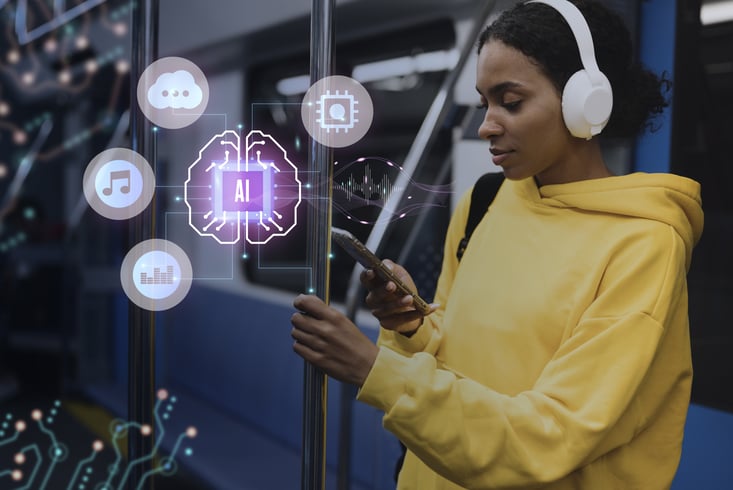Generative AI is a rapidly growing field with the potential to revolutionize many industries. Generative AI models can be used to create new content, such as text, images, and music, that is indistinguishable from human-created content. This has led to a wide range of potential applications, such as generating realistic news articles, creating personalized marketing campaigns, and designing new products.
Traditionally, generative AI models have been built using a technique called prompt engineering. In prompt engineering, the model is given a specific prompt that tells it what to generate. For example, to generate a news article, the model might be given the prompt "write a news article about the latest developments in AI." This approach has been successful in generating high-quality content, but it has some limitations.
One limitation of prompt engineering is that it can be difficult to come up with the right prompt for every task. For example, if you wished to generate a poem, you might need to come up with a very specific prompt that captures the essence of the poem you want to create. This can be time-consuming and challenging, and it can limit the creativity of the model.
Another limitation of prompt engineering is that it can be difficult to control the output of the model. For example, if you want to generate a news article about a specific topic, you might need to use a very specific prompt that specifies the topic. However, this can limit the flexibility of the model and make it difficult to generate different types of content.
Autonomous agents offer a new approach to building generative AI models. Autonomous agents are software programs that can act independently to achieve a goal. In the context of generative AI, autonomous agents can be used to generate content without the need for human intervention.
Autonomous agents can overcome the limitations of prompt engineering in several ways. First, autonomous agents can learn to generate content without the need for human-provided prompts. This allows them to be more creative and flexible in their output. Second, autonomous agents can be given goals that are more general than specific prompts. This allows them to generate different types of content that are still relevant to the goal. Thirdly, these agents can make decisions on their own without any human intervention and can achieve the goal with a set of provided tools.
In addition to overcoming the limitations of prompt engineering, autonomous agents also demonstrate real intelligence in the following ways:
- They can use the right prompts themselves. Autonomous agents can learn to identify the right prompts for a given task, without the need for human intervention. This allows them to be more efficient and effective in their output.
- They can validate the output. Autonomous agents can evaluate the output of their generation process and make adjustments as needed. This ensures that the output is of high quality and meets the user's requirements.
- They can apply multiple iterations. Autonomous agents can generate content iteratively, making improvements each time. This allows them to create high-quality content that is tailored to the user's needs.
- They can learn from their mistakes and improve over time. Autonomous agents can learn from their mistakes and improve their performance over time. This allows them to become more intelligent and capable of generating high-quality content without human assistance.
The future of generative AI is exciting and full of possibilities. Autonomous agents have the potential to make a real difference in our world, and we are only just beginning to explore their potential.
Here are some specific examples of how autonomous agents could be used to generate content in the future:
- Personalized educational content: Autonomous agents could be used to generate personalized educational content for students of all levels. This content could be tailored to the individual student's learning style and interests.
- Insurance underwriting: Autonomous agents could be used to autonomously perform all the actions of an underwriter. This could include reviewing applications, assessing risk, and making underwriting decisions. Autonomous agents could be used to improve the efficiency and accuracy of the underwriting process. They could also be used to make underwriting decisions that are fairer and more equitable.
- Actions of a Travel agent: Autonomous agents could be used to autonomously perform all the actions of a travel agent. This could include booking flights, hotels, and activities; providing travel advice; and handling customer service inquiries. Autonomous agents could be used to improve the efficiency and convenience of the travel planning process. They could also be used to provide personalized travel recommendations based on each individual's interests and needs.
These are just a few examples of the many ways that autonomous agents could be used to generate content in the future. As autonomous agents continue to develop, we can expect to see even more innovative and creative applications of this technology.
In addition to the potential benefits of autonomous agents for generative AI, there are also some potential risks that need to be considered. For example, autonomous agents could be used to generate harmful content, such as hate speech or propaganda. It is important to develop safeguards to prevent this from happening.
Overall, the potential benefits of autonomous agents for generative AI outweigh the risks. Autonomous agents have the potential to revolutionize the way we create and consume content. As the advancement of this technology unfolds, it is of utmost importance to stay mindful of the potential risks involved and to proactively establish protective measures to ensure our safety.
About Coforge
Coforge is a global digital services and solutions provider, that enables its clients to transform at the intersect of domain expertise and emerging technologies to achieve real-world business impact.
We can help refine your problem statement, crystallize the benefits, and provide concrete solutions to your problems in a collaborative model.
We would love to hear your thoughts and use cases. Please reach out to Digital Engineering Team to begin a discussion.

Khushboo Goyal is a Senior Consultant at Coforge with over 18 years of industry experience. A specialist in Agentic AI and Generative AI, she focuses on building autonomous frameworks, Virtual Assistants, and advanced RAG architectures. With a strong foundation in Machine Learning, Khushboo Goyal consults in strategic AI initiatives to deliver high-impact, practical enterprise solutions.
Related reads.
About Coforge.
We are a global digital services and solutions provider, who leverage emerging technologies and deep domain expertise to deliver real-world business impact for our clients. A focus on very select industries, a detailed understanding of the underlying processes of those industries, and partnerships with leading platforms provide us with a distinct perspective. We lead with our product engineering approach and leverage Cloud, Data, Integration, and Automation technologies to transform client businesses into intelligent, high-growth enterprises. Our proprietary platforms power critical business processes across our core verticals. We are located in 23 countries with 30 delivery centers across nine countries.


